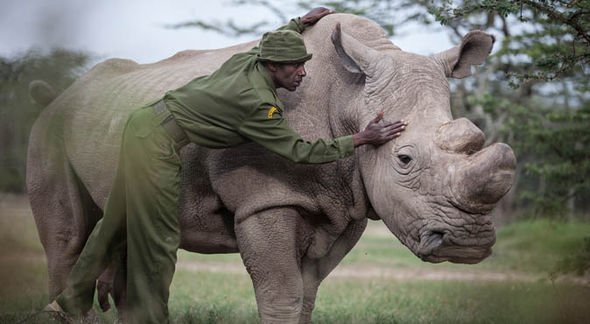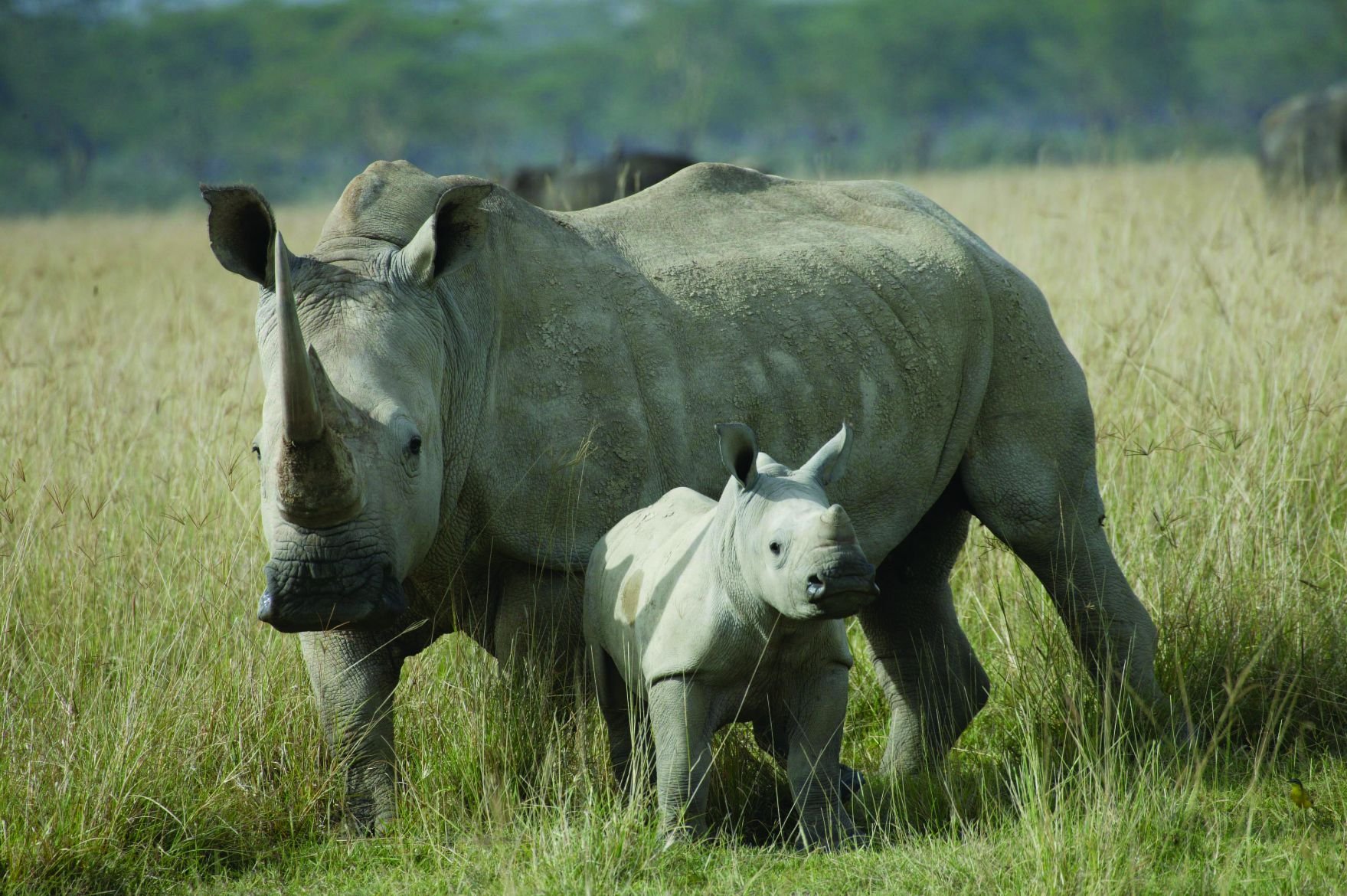When I first met a Rhino, my breath was completely taken away by their sheer beauty, their gentle nature and their love for a scratch behind the ears. This moment happened in 2015 and I will never forget looking into the eyes of one of the worlds most endangered animals that zoos are desperately trying to save from extinction.

There is a one image in this post that may be upsetting
Description
There are two species of White Rhino (Ceratotherium), the Northern White Rhino and Southern White Rhino, for a long time it was thought that the Northern and Southern White Rhino were subspecies of one and other, but further research has concluded that they are likely two separate species of Rhino.
When comparing the two species they do have some distinct differences, the Northern White Rhino is considerably smaller than the Southern White Rhino, on average weighing around 400-800Kg less with a maximum weight of around 1600Kg, they also have smaller and flatter skulls, less pronounced and shorter horns, and have distinctly hairier Ears and Tail than those observed on the Southern White Rhino.
Northern White Rhino are distinguishable by their outline as well, their hump at the base of their skull is more pronounced than other Rhino species and their head generally hangs lower than other species of Rhino, this is due to their large Neck muscles that are required to support their head, as such a Northern White Rhino constantly looks downward, only raising their h when they are alarmed or spooked by something.
Despite being called the White Rhino, they are not White at all, like all other living species of Rhino in Africa they are Grey, and without viewing some of the characteristics mentioned previously, they could be mistaken for the Black Rhino.
Social Behaviour and Reproduction
The gender of the Rhino plays a large factor in the size of their chosen territory, female Rhino generally inhabit an area 6-20km2 in size whereas males choose much smaller territories often <3km2, this allows the male to more easily defend an area of land from rival males. Female Rhino will often ensure that their territory overlaps several male territories, this ensures that breeding is varied, which is important as White Rhino are typically sedentary animals that rarely stray from their territory, limited partners would result in a weakened gene pool with less geographical distribution.
Males will spend up to twenty days with females when the female enter oestrus, the male will be alerted to this opportunity as the female will give off a special scent in her Urine to attract a mate, once the pair have successfully mated the male white Rhino will return to his territory, he will have no role in his offspring’s upbringing. Aside from when female Rhino are in oestrus male White Rhino live a largely solitary existence, only encountering other males when they are either challenged for territory themselves, or if they have matured in size and are interested in expanding their territory, mature Bulls will often have the largest and most bountiful territory as territory can be hard to come by in their harsh environment the dominant bull will allow several smaller males to exist in satellite territories around his chosen land, the mature bull will learn their scents and will challenge any male that he does not associate with the satellite territories. Female White Rhinos live a far more sociable existence as past the age of 6/7 they will begin to yield calves, gestation takes roughly 470-550 days, once born the calf will rely on its mothers’ milk for up to one year and will also begin to graze on grassland at around 2 months old, the calf lives by its mothers’ side for up to 3 years, at which point the female will once again enter oestrus and attract a male to breed. The 3-year-old calf will then leave its mothers’ territory and will likely pair up with a Rhino of similar age and gender until it reaches sexual maturity at age 6/7 for females and 10/12 for males.Prior to population decreases, habitat destruction and poaching Female White Rhinos would also congregate in groups of 5-6 individuals known as ‘crashes’, the female would only proceed to leave the crash once she had given birth to a calf at which point she will mark her own territory.
The Path to Extinction
As part of my Endangered Animals series this section will usually be home to the threats as when it comes to saving a species from extinction prevention is much better than cure.
Rhinos are facing a huge decline in numbers across Africa due to hunting and habitat loss as lands were used for agriculture, livestock management, plantations and other urban developments. In the 70’s and 80’s the poaching crisis took over fuelled by the huge demand from Asian countries for traditional medicine that the Northern White Rhino and Black Rhino became extinct in Uganda. The last wild population of the Northern White Rhino lived in the Eastern DRC’s Garamba National Park until the early 2000s. During the 1990’s the population numbers within the park fluctuated between only 20-30 individuals. In 1995 a proposal was made to try and relocate animals into safer parts of Africa to create an insurance policy population that relied on two Zoos that held the NWR’s send their animals to join them. Sadly, for whatever reason, the proposal was declined due to the Zoos not cooperating.In 2005, the second attempt was made that the Congolese government gave permission to move 4-5 animals from Garamba to Ol Pejeta Conservancy in Kenya however, once again humans failed and the government changed its mind ensuring the failure of this project. Sadly, that meant the last chance to create an insurance population breeding group had been lost. During the Congolese Civil War, the Garamba National Park was the centre of the extreme violence where Rebels and Janjaweed Militia groups crossed into its borders, they used Rhino horn and Ivory to raise funds for their cause that in 2006, the last rhino conservation program ended due to safety fears for the staff and that the population dropped to a measly four animals thus not enough animals to breed. In 2008, it was assumed that the population had become extinct due to extensive surveys in the air and on the ground, the surveys did not find any live or dead animals.
In 2009, the last four NWR were finally relocated to the Kenya’s Ol Pejeta Conservancy from Dvur Kralove Zoo to tempt the rhinos into breeding with new surroundings and other rhino companions. Sadly, it was found that the remaining animals were related in some way and experienced a variety of fertility problems and have failed to breed.For the Northern White Rhino, they are now classified as effectively extinct. Although there is a small glimmer of hope with the innovations such as IVF for animals like Rhinos that are still being perfected, it will likely come too late to save this subspecies.
There are now only three yes that’s right there are THREE individuals remaining that are either too old like Sudan who is 42 years old with a low sperm count, or have reproductive problems that prevents them from conceiving naturally. Fatu is 15 and could breed but after continuous efforts she has yet to conceive, and Najin 25 who’s back legs are so weak she would be unable to support a male mounting her. Sadly, the death of the last Northern White Rhino in this world is only a short matter of time away, how devastating- Congratulations to the human race for screwing over a beautiful and an amazing species.Save the Rhino supports ongoing rhino conversation programs by providing the projects with funding with grants. They believe that the best outcome will be to put all efforts and funding into IVF research that could still save the species. We can learn a lesson from the Northern White Rhino and stop the same fate as their cousins the Javan and Sumatran Rhinos that are now classified Critically Endangered both of which are less than 100 individuals that is rapidly declining.
Keeping them safe
At the Ol Pejeta, there is a dedicated 24hr armed security team safeguarding his 700-acre enclosure. In 2012, expectations were increased, Suni was seen mating with Najin, after 16 months it was clear that she was not pregnant. It was decided that considering that there are only 4 left that a southern white rhino would be introduced to the two remaining females to preserve some of the genes but again this proved to be unsuccessful. In 2014, Suni died suddenly of natural causes that left Sudan as the only male NWR in the world that found in 2015 to be incapable of breeding due to a low sperm count which is not a surprise at his age. It was also found that both females were unable to reproduce naturally. July 2015 saw the loss of Nabire at Dyur Krazlove Zoo in Czech Republic leaving just THREE Northern White rhinos on the planet.
Final Thoughts

It is despicable that as a species we have managed to wipe out one amazing species. Having met Rhinos in the flesh

It is such a backward thought considering the amount of research that has gone into establishing the science behind the belief where there isn’t that much evidence to support the plethora of claims that there are healing properties in the horns of Rhinos – they may as well chew their own nails! I do not want my children growing up in a world without Rhinos living in the wild, I hope to one day fly out to Africa and see them for myself.

I am incredibly proud to say that a colleague of mine is currently working for Care for the Wild that rescues and
How you can help
They need all the help you can give them...
Donate directly to the Ol Pejeta Conservancy
Adopt Sudan, Fatu & Najin
Overall, we have screwed up any chances for the Northern White Rhino, let’s try and save the others from the same fate.










